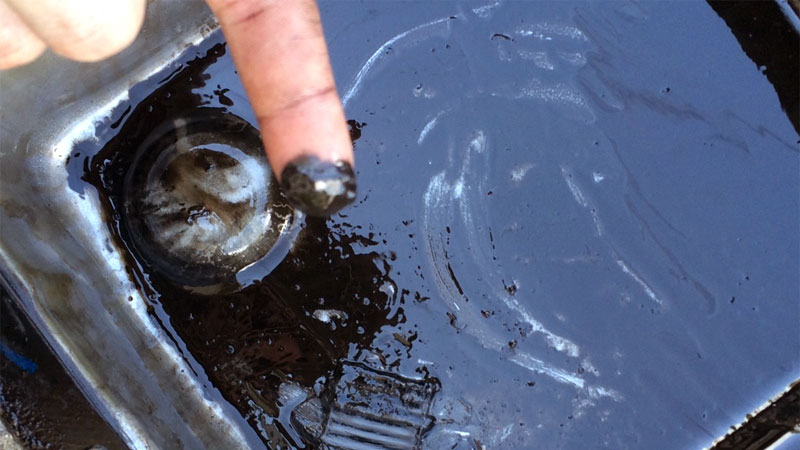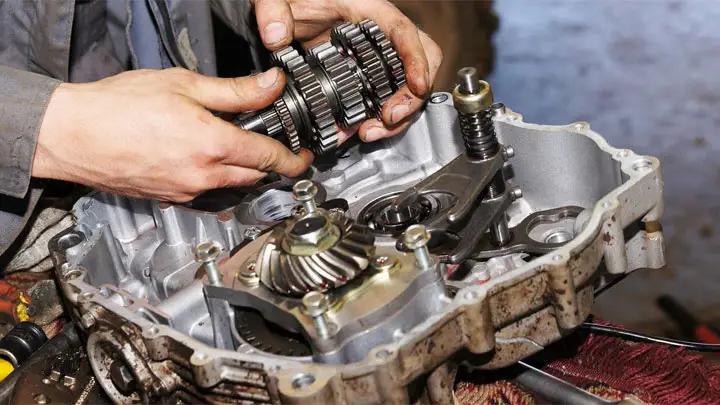1. Begin by checking your transmission fluid level and color. If it is dark brown or black, you need to replace the fluid immediately.
2. Next, locate the drain plug at the bottom of the transmission and remove it to allow any old, burnt fluid to be drained out.
Be sure to have a replacement pan on hand in order to catch all of the drained fluid.
3. Once all of the old fluid has been removed, re-install and tighten up the drain plug securely before adding new transmission fluid as per manufacturer’s specifications into your car’s transmission system using a funnel or other appropriate tool for accurate measurements..
4. After refilling with fresh fluids securely close off its lid and start up your engine so that you can recirculate clean oil through it while simultaneously warming up its components like gears which will help get rid of any debris present inside them due to burning or contamination issue causing further damage while also ensuring proper lubrication within its parts is maintained throughout entire operation process .
- Check the Level: Before attempting to fix a burnt transmission fluid issue, it is important to check the level of transmission fluid in the vehicle
- If the fluid reserves are low, then a refill of new transmission fluid may be sufficient to remedy the problem
- Change Filter and Fluid: If topping up with fresh transmission fluid does not solve the problem, then replacing both filter and fluids should be done next as this will help remove any contaminants from within your system that could have caused burning or other issues
- 3
- Inspect Internal Components: In some cases, internal components such as clutches and bands may need inspection if they are exhibiting signs of wear or damage due to overheating caused by burnt transmission fluids
- These components should be replaced if needed for optimal performance of your vehicle’s transmission system going forward
- Take Vehicle For Test Drive: After all repairs have been completed, take your car out on a test drive and listen closely for any strange noises coming from underneath your hood which could indicate further problems with your transmission system after fixing burnt oil issues
Top 5 Burnt Transmission Fluid Symptoms
What Happens If My Transmission Fluid is Burnt?
If your transmission fluid is burnt, it can potentially cause severe damage to the transmission system. Burning of the transmission fluid indicates that there is excessive heat in the system which could be caused by a number of different issues such as low levels of fluid, an issue with the torque converter, or a clogged filter. As this burning continues over time, it will start to break down and become less effective at lubricating and cooling the moving parts within your vehicle’s transmission system.
This can lead to increased wear and tear on these components which could eventually result in complete failure and expensive repair bills if not addressed quickly enough. It’s important to have any suspected burning of your transmission fluid checked out immediately so that you can prevent further damage from occurring. Additionally, make sure to check all other fluids regularly for proper levels so that you don’t experience similar issues in future!
Should You Flush Burnt Transmission Fluid?
No, you should not flush burnt transmission fluid. Flushing the fluid can cause further damage to your transmission and lead to major repairs that may be more costly than if you just replaced the burnt fluid in the first place. The heat generated from burning the fluid causes a buildup of sediment and varnish deposits which can clog filters, contaminate other lubricants, and reduce viscosity levels.
This will make it harder for your transmission to operate properly as well as increase wear on its internal components. Additionally, flushing out potentially damaged parts with new oil could actually drive those particles deeper into the system where they can cause even more problems down the line. It’s best practice to replace your old burned-out transmission fluids before attempting any kind of flush procedure due to these potential risks associated with using this method.
Will Burnt Transmission Fluid Cause Hard Shifting?
Burning transmission fluid can cause hard shifting in an automatic transmission. This occurs when the fluid is overheated and its lubricity is reduced. In some cases, the automatic transmission may shift into a higher gear even though it should be in a lower one.
Additionally, the vehicle may not shift at all, or take longer than normal to do so. Burning transmission fluid can also lead to damage of internal components as well as accelerated wear on parts like clutches, bands and seals that are used to engage gears within the gearbox. The issue can become worse if left untreated for too long since burnt tranmission fluid may lead to further component damage or complete system failure over time.
What Causes Burn Transmission Fluid?
Burning transmission fluid is a common issue that car owners experience. The cause of this problem typically lies in the lack of regular maintenance or neglecting to replace worn-out parts. Transmission fluid plays an important role in lubricating and cooling the internal components of your vehicle’s transmission system, so when it starts to lose its effectiveness due to age or wear, you may start experiencing problems with your transmission.
Common causes of burning transmission fluid include low levels caused by leaks, overfilling, contamination from dirt or metal particles, and failure to change the filter regularly. Additionally, if there is too much friction between moving parts due to worn-out seals and gaskets that are not replaced as needed can lead to overheated fluids which will burn off quickly during operation. If you suspect that your car is burning through its transmission fluid at an alarming rate then it would be wise for you to visit a professional mechanic who can diagnose and repair any underlying issues before further damage occurs.

Credit: oards.com
Burnt Transmission Fluid Symptoms
Burnt transmission fluid is a common problem that can occur in automatic transmissions. Symptoms of burnt transmission fluid include dark brown or blackish color, an unusual burning smell, and small metallic flakes or particles in the fluid. Additionally, you may experience difficulty shifting gears, delayed responses from the gear shifts, increased fuel consumption, and jerking motions when changing gears.
If you suspect that your vehicle has burnt transmission fluid it’s important to bring it to a qualified mechanic for diagnosis and repair as soon as possible.
Burnt Transmission Fluid And Slipping
When your vehicle’s transmission fluid is burnt, it can cause the clutch to slip. This happens because the thickness of the fluid deteriorates over time and no longer provides enough lubrication for the gears and other components in your transmission. Slipping can be a symptom of a larger problem with your car’s transmission that should be addressed by an experienced technician as soon as possible.
Driving With Burnt Transmission Fluid
Driving with burnt transmission fluid can be a serious risk to your vehicle. It reduces the lubrication of the internal components, leading to accelerated wear and tear on parts such as bearings, seals and other critical components. A lack of proper lubrication also causes higher temperatures in the transmission – which increases friction and leads to further damage.
If you suspect that your transmission fluid is burnt or contaminated, it’s important to have it flushed out by a qualified technician as soon as possible.
Conclusion
Fixing burnt transmission fluid doesn’t have to be a daunting process. With the right tools and knowledge, you can easily get your vehicle back in working order. It is important to properly diagnose the issue before attempting any repairs as this could cause further damage if done incorrectly.
By following the steps outlined above and taking extra precautions, you should be able to fix your burnt transmission fluid quickly and efficiently.



